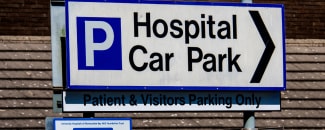The cameras use high-tech algorithms to scan and decipher each vehicle number plate. When a number plate is detected, the image is recorded and stored. Optical Character Recognition (OCR) is used to decode the registration and this is stored along with the date and time that the image was taken. Recording the entrance and exit times of each vehicle allows the length of the stay to be determined.
ANPR data is typically used for enforcement purposes and not much else. The information can determine which cars have overstayed in the car park and issue parking tickets. As the parking tickets are not issued there and then, the companies use the DVLA’s vehicle keeper database to access the keeper’s details and send a ticket through the post. ANPR can be used 24 hours a day and is generally efficient at identifying cars which have overstayed.
ANPR for security, and to implement dynamic pricing
Some operators also use the technology for the security that it offers. Car parks are monitored 24 hours a day, keeping an eye on everyone coming and going. This can help to reduce vehicle thefts and, if a theft does occur, footage can be provided to the police.
However, there is huge untapped value within ANPR solutions. There is the potential for so much more to be done with this technology. A great deal of ANPR data is left unused and ignored. But this data is incredibly valuable and can be used in a number of ways.
As ANPR records all vehicles entering and exiting the car park, this means that it is possible to monitor the occupancy of the car park at all times. This data can be used to implement dynamic pricing, which involves varying car park charges at different times depending on demand. For example, weekend prices may be more expensive than during weekdays if your car park is in an area that is popular with tourists, or vice versa if your car park tends to be used by commuters and businesses. The ANPR data can be used to guide tariff decisions. For more information about dynamic pricing for parking, check out our blog “The benefits of dynamic pricing for parking”.
In addition, vacant bays can be advertised on YourParkingSpace, enabling operators to monetise what would otherwise be empty space. Letting drivers know where and when spaces are available is a huge incentive for them to use your car park. In a recent survey, 55% of drivers said that concern over finding a parking space had led them to cancel or postpone a trip. Combining the convenience of ANPR and YourParkingSpace means that drivers can check in advance whether there is a space available. They can even pre-book their parking spot so that it’s waiting when they arrive.
ANPR to measure customers' levels of satisfaction
Other data that can be gathered via ANPR includes tracking the number of repeat visitors to the car park. This could be useful for measuring levels of customer satisfaction. Satisfied customers are more likely to be repeat visitors. If there are few repeat visits, this could be a sign that something needs to change to make your car park more attractive to drivers. You could also develop a loyalty scheme for repeat customers. This could be particularly lucrative if your car park tends to be used by commuters on a daily basis. If there is an incentive for repeat visits, regular drivers in the area are more likely to choose your car park over any other.
Understanding the length and frequency of visits to your car park is important in building up a pattern of demand. This will then feed into dynamic pricing strategies. ANPR can also be used within the car park to determine where customers prefer to park. Premium pricing could then be introduced for parking spots that are most preferred due to perceived convenience.
The percentage of electric vehicles entering your car park can also be tracked. This can help to guide decisions about electric charge point installations. Electric vehicle use has increased over recent years and drivers of electric vehicles are often looking for convenient places to charge their cars. Determining how many electric charge points to install in your car park is an important decision. Too many means wasted resources, but too few means that your car park may not be able to meet demand and drivers may choose to park elsewhere. ANPR data can help you get this right.
ANPR makes payments easier for drivers
ANPR can also be used to increase convenience for drivers. It can provide a solution for seamless payments. Customers can register their vehicle registration number and payment details. They can then be charged automatically based on the times they enter and exit the car park. Ticket less parking is extremely attractive to drivers. It saves time and means that there is no need to worry about carrying cash or potentially losing tickets. For more information on cashless parking solutions, have a look at our blog “Why every car park should offer a cashless payment option”.
A key point to keep in mind is that the British Parking Association states that signs at the car park must tell drivers that ANPR is being used and what the data captured by the ANPR cameras will be used for. This is important to consider when you are thinking about the different ways you may want to utilise ANPR data.
ANPR can be an efficient and valuable tool in car park management. Data gathered by ANPR can be used, not only for enforcement, but also to increase revenue for car park operators and offer extra convenience for drivers. There is a great deal of untapped value within ANPR solutions. Our handy blog has provided you with plenty of ideas so that you can now start taking advantage of this exciting opportunity.








